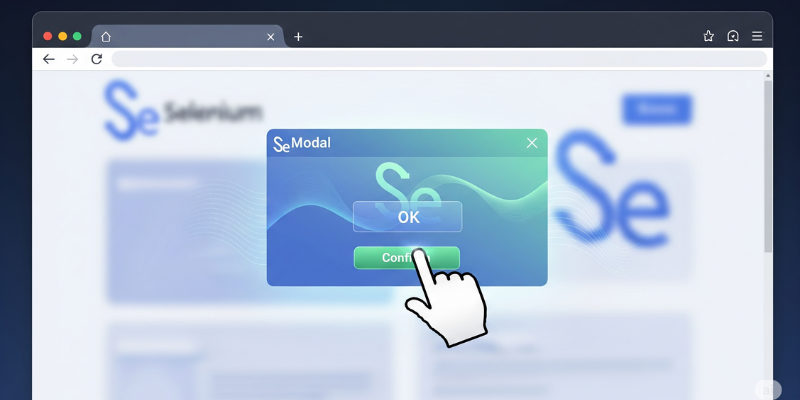In web automation testing, handling modal popups is a skill every tester must master to ensure smooth and reliable test execution. These popups often appear at critical stages, such as login confirmation, alert messages, or user input prompts, and failing to interact with them correctly can disrupt the flow of automation scripts. For those aiming to excel in automation frameworks and develop hands-on expertise, enrolling in Selenium Institute in Bangalore provides structured guidance on tackling real-world scenarios like popup handling with confidence and precision.
Understanding Modal Popups and Their Role in Testing
Modal popups are interactive components that appear on top of a webpage, preventing users from accessing the underlying page until they perform a required action. These can range from simple alert boxes to complex forms requiring user input. In Selenium automation, testers must learn how to handle these elements efficiently because a missed interaction can lead to failed test cases, inaccurate results, or incomplete workflows.
Unlike regular elements, modal popups are not always part of the main document object model (DOM), and they may require switching contexts or applying specialized commands to interact successfully. Understanding these differences is the foundation of reliable automation testing.
Types of Modal Popups You May Encounter
Modal popups can vary based on their functionality and how they are triggered within a web application. The most common ones include:
JavaScript Alerts – These are simple popups used for notifications or confirmations, often appearing as alert, confirm, or prompt dialogs.
HTML Popups – These are built using HTML and CSS and require locating elements within them to interact.
Authentication Popups – Typically seen during login, they require entering credentials to proceed.
Each of these popup types requires different handling strategies, and Selenium provides a variety of methods to manage them effectively.
Switching Control to Modal Popups in Selenium
To interact with modal popups, Selenium provides specific commands that shift focus from the main webpage to the popup window. For JavaScript alerts, the switchTo().alert() method allows testers to accept, dismiss, or retrieve text from popups. For HTML popups, testers need to identify elements inside the popup using locators like XPath or CSS selectors and perform actions such as clicking, typing, or verifying displayed information. When dealing with authentication popups, handling may involve integrating Selenium with external tools or passing credentials within the URL itself.
Challenges in Handling Modal Popups
Working with popups may seem straightforward, but beginners often encounter a series of challenges. One common issue is NoAlertPresentException, which occurs when scripts attempt to interact with a popup before it appears. Another frequent challenge involves synchronization problems, especially with popups that load dynamically. Advanced learners often tackle these scenarios through explicit waits, verifying popup presence, and applying conditional checks to ensure smooth execution. Here hands-on practice becomes crucial, and those who have undergone structured training like students from Selenium Training in Hyderabad gain the confidence to handle these complexities through practical exposure and real-time case studies.
Synchronization: Ensuring Timing Accuracy
Since popups can appear at unpredictable times, incorporating waits into automation scripts becomes essential. Selenium offers explicit waits, where scripts pause until specific conditions are met, ensuring that modal popups are available before interaction begins.
This approach minimizes execution errors, prevents flaky tests, and builds reliability into automation workflows. Additionally, testers are encouraged to use dynamic locators for HTML popups to accommodate design changes in web applications, further enhancing test stability.
Real-World Scenarios of Modal Popup Handling
Popups often appear in critical testing stages such as:
Login Validation – A confirmation popup after successful login.
Form Submission – A modal confirming that user data has been submitted.
E-commerce Transactions – Popups that appear during payment gateways or checkout processes.
By mastering popup handling in these scenarios, testers ensure smooth user journeys, accurate data validation, and seamless integration across different parts of web applications. Gaining this expertise through Selenium Training in Pune equips learners with practical skills to handle real-time challenges and build confidence for career growth in automation testing.
Advanced Tips for Professionals
As testers advance, they encounter scenarios where multiple popups appear in sequence or where popups exist within iframes or nested structures. Handling such cases requires not only technical skills but also a deep understanding of web application behavior.
Combining Selenium with other frameworks like TestNG or integrating it with reporting tools can help in tracking popup interactions and capturing results more efficiently. Furthermore, creating reusable utility functions for popup handling enhances test modularity and reduces redundancy across projects.
Building Career Confidence Through Practical Exposure
Mastering modal popup handling is not just about writing correct code; it is about developing strong problem-solving skills that make testers stand out in dynamic IT environments. Automation professionals who gain practical exposure through guided learning paths build a solid foundation for managing complex UI interactions with ease. Hands-on practice, real-world scenarios, and structured learning ensure that theoretical knowledge transforms into confident, industry-level performance.
Handling modal popups is a crucial skill in Selenium automation, requiring precision, timing, and practical experience to ensure reliable test execution. By understanding popup types, mastering synchronization techniques, and applying advanced strategies, testers can significantly improve the accuracy and stability of their automation projects. For beginners and professionals aiming to develop strong testing capabilities and advance their careers, Selenium Training in Chandigarh provides the perfect foundation for building expertise that translates into real-world success.
Also Check: Mastering Data-Driven Testing for Login Systems




Top comments (0)